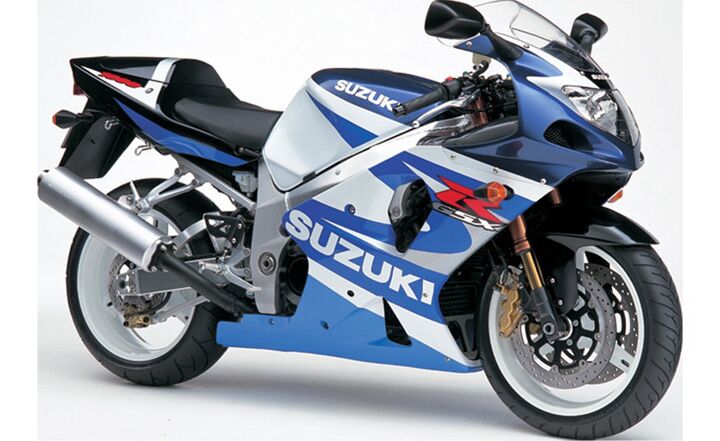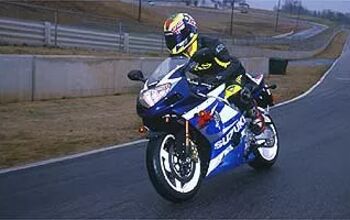Church Of MO – First Ride: 2001 Suzuki GSX-R1000

In a few day’s time you’ll get to read all about the brand new 2017 Suzuki GSX-R1000, Suzuki’s most advanced GSX-R to date. Penning the story will be none other than MO‘s E-i-C Kevin Duke, who did his best to tame the beast around one of the most loved racetracks in the world: Phillip Island in Australia. But before we talk about the new bike, let’s go back to the GSX-R1000’s roots; 2000 in this case. For this week’s Church feature we’re bringing you the First Ride review of the 2001 Suzuki GSX-R1000 – Suzuki’s answer to the liter-class sportbike wars started by Yamaha’s YZF-R1 a couple years prior.
First Ride: 2001 Suzuki GSX-R1000
Exquisite Agony
Atlanta, Georgia, December 11, 2000 — Note to Yoshimura and other like-minded tuners: This is one bike that does not need any help. Even fitting the most effective and efficient exhaust system would be like attaching a bottle rocket to an ICBM. What’s the point?
There is, of course, no rational reason for the GSXR1000 — it’s purpose is all about adrenaline spikes, filling that need for speed, and finally making sportbike junkies the world over believe that fast enough really is fast enough. Based on the incredibly competent and compact GSX-R750, this newest open class contender has raised the bar for power output from a given displacement and then wrapped it up in a chassis that will make real racers smile. The stock Bridgestone tires worked well, able to put the nearly 150 rear wheel horsepower to the ground. But because of the prodigious power this 988cc motor produces, the rear tire — no matter what you choose to fit — will always be in a state of exquisite agony.When we found out that the worldwide press introduction would be taking place at Georgia’s excellent Road Atlanta facility, we were a bit worried. We had just finished up the GSX-R600 intro there only a few weeks prior. So we had an idea of the things that were to come after hearing rumors and leaks about just how un-godly this new Suzuki would be. The last vision we had before drifting off to sleep before the intro was that of sliding down the hill towards the wall at the bottom of turn eleven, after being jettisoned off the big bike coming over the rise that is turn eleven and used to be at the end of the infamous Gravity Cavity.
On the GSX-R600, we were quite impressed with that bike’s ability to rail through turn nine, an ultra-fast right hander that bends over a rise, in excess of a buck-fifty and some change. The new thousand, however, accomplishes the feat a fair bit quicker. How much? How about routinely seeing a numeral one, followed by a numeral eight, followed by other numbers that flashed about too rapidly to make any really precise calculation of terminal (good word choice, there) velocity possible before having to squeeze on the binders.Sure, high speeds are great, but there’s a few things to remember here in regards to the way the new thousand handled itself. Namely, that turn nine was taken in the top of fifth gear, so there was still one more gear to pull. Also, this newest Gixxer was able to crest the rise, on the throttle, over the bumps, with less fanfare than the 600 was able to muster at substantially lower speeds.
The chassis on this new GSX-R1000 is based on the GSX-R750, one of our favorites for the past year. Stiffening up the outer walls of the main frame by 0.5 mm was the only thing the Suzuki engineers felt was needed to contain significantly more power lurking between the aluminum (pronounced, al-you-min-e-um , according to the Brits present) spars. Of the differences between the bikes, our favorite bit has to be the titanium nitride coated fork stanchions. Not only do the forks work well, but they look cool, too.
We were treated to two days of riding with the first being dry and chilly, the second, miserably wet and cold except for the last session of the day which was only damp off-line, yet almost unbearably cold. And we continue to wonder why people want our jobs…It would come as no surprise to anybody that the current open class benchmark, Yamaha’s YZF-R1, is the target Suzuki’s engineers were gunning for. With what has been — until now, anyway — the sharpest overall package ever produced in extra-strength, take-home variety, that was a lofty goal indeed. It’s a goal that even Honda had a bit of a fit trying to eclipse with their latest Fireblade iteration, the CBR929RR.
Now, with the GSX-R600, it was possible to ride with a very 250-esque style. Lots of lean angle, high corner speeds and big handfuls of throttle on the way out, sometimes even on the way in. You try that with that bike’s big brother and you’ll find your bike in the gravel pit… if you can find it at all. With this much power underfoot, you need to be delicate with throttle application. Whacking things about is a very bad idea.
Bending into a corner as you trail off the excellent Tokiko six-piston calipers grabbing each rotor, the bike bends in with the sort of alacrity usually reserved for bikes 400cc’s its junior. Specs that say how closely this bike resembles its 750 and 600 brothers only mean so much, and we remain skeptical until track time turns intangibles into sweat stains and, um, other stains, too.
While this bike does feel similar to its smaller siblings, there is no hiding the added weight and reciprocating mass. Quick side-to-side flicks make the pounds apparent, but this bike is so far ahead of it’s now aged predecessor, a comparison in that direction isn’t adequate, hence all these 750 references.
Once turned-in to a particular corner, like number five — a downhill right-hander with an 18-inch good line through the apex to avoid the majority of the bumps — this chassis telegraphs an amazing amount of feedback to the rider. And the chassis responds just as sharply to every input a rider makes to adjust or correct his position at any given moment.
Through the middle of the corners, it was easy to load the front end, even with the throttle cracked and rail out just as if you were on a far more diminutive bike. Front-to-rear balance was good, as was a rider’s ability to tailor handling characteristics to suit a given situation or riding style.
But as soon as the corner ended and we were able to open the throttle slides, there was no mistaking this for anything but an open-bike with class-leading power.
Because, when you’re dealing with horsepower numbers that reside well into the triple digits, its important to exercise some high degree of throttle control on corner exits. Fast guys like 500GP World Champion, Kevin Schwantz, were able to set their exit line out of the corner using a healthy dose of throttle, albeit applied smoothly. Up out of turn one, heading up the hill, big darkies were laid down even with the front wheel in the air. Power is nothing without good control, and this bike has got it in spades, no doubt.
How does one go about turning a “standard” superbike into an open bike? If you’re Suzuki, you simply take a GSX-R750, stiffen chassis, increase engine displacement and shake. The resulting intoxicating concoction is the GSX-R1000. In fact externally they are very similar. Sporting identical wheelbase, footpeg, handlebar and seat locations, and rake and trail angles, riders of the 750 can easily adapt to the 1000. Except, of course, for the new engine.
If you were to compare the engines from the GSX-R750 and the 1000, you’d notice some differences. Notably, the fact that its 15 millimeters taller and 6 millimeters longer while the width remains identical. The new engine sports a larger crankcase to support the larger bore and stroke. Other differences include a larger clutch, wider transmission gears and larger crank journals. Some completely new parts in the engine include an air-cooled oil-radiator and a compact counter-balancer mounted in front of the crankshaft.
Further modifications include the development of the Suzuki Exhaust Tuning system. This digitally controlled systems uses a servo motor to control a butterfly vale in the exhaust to regulate back pressure. The exhaust flows out of a unique 4-into-2-into-1 system that is constructed of titanium, aluminum and stainless steel. On the inlet side, a secondary throttle valve system is used to keep inlet velocity stable. The valve is controlled by a stepper motor mounted directly to the throttle body.
The addition of one more motor mount on the right frame spar and the aforementioned thickening of the main frame rails help keep the engine from twisting about in the chassis. The swingarm, although identical in size, was stiffened through the use of a dual box-section design, whereas the 750 is of single-box construction.
Six-piston calipers up front help put a rein on all the new-found power and are lighter than the ’99 GSX-R750’s caliper by 120 grams per unit. 180 grams was also shaved from the rear disc while 60 grams was reduced from the rear brake caliper. Despite these weight reducing measures, the 1000 weighs 10 more pounds than the 750. Much of this weight can be attributed to the use of a wider rim and tire, the aforementioned chassis stiffening measure and in the changes in the engine.
Excellent brakes, smooth tranny and good fuel mapping of a motor whose destiny is, it seems, to re-invent the open class just as the first GSX-Rs did back in 1985.
Is it better than Yamaha’s R1? Well, it sure feels like there’s more mid-range pull and, perhaps, a good seven more ponies up top. Weight felt similar, but there’s definitely a difference in riding position and the best way to get each bike through a given bend.
So, did the Year 2001 GSX-R1000 scare us like we thought it might? Not exactly, though it did make us tremble from time to time. And where open bikes are concerned and big power wheelies and darkies are the name of the game, this latest Suzuki thrills like no other ever has before.

Troy's been riding motorcycles and writing about them since 2006, getting his start at Rider Magazine. From there, he moved to Sport Rider Magazine before finally landing at Motorcycle.com in 2011. A lifelong gearhead who didn't fully immerse himself in motorcycles until his teenage years, Troy's interests have always been in technology, performance, and going fast. Naturally, racing was the perfect avenue to combine all three. Troy has been racing nearly as long as he's been riding and has competed at the AMA national level. He's also won multiple club races throughout the country, culminating in a Utah Sport Bike Association championship in 2011. He has been invited as a guest instructor for the Yamaha Champions Riding School, and when he's not out riding, he's either wrenching on bikes or watching MotoGP.
More by Troy Siahaan

































Comments
Join the conversation
Those were awesome bikes. Big power never goes out of style. No electronic aids either...
We had a well-heeled customer who purchased one of these beauties, crashed it, then bought another as his first bike was being repaired. He kept both.
This bike was a game-changer.